Acute
In 1923 the Poor Law Guardians purchased Oster Hills House for use as a Nurses' Home.
A children's block was added to the site during the 1930s.
At the beginning of WW2 in 1939 Oster House joined the Emergency Medical Service, under the control of the Royal Free Hospital.
In 1946 the workhouse building became part of Osterhills Hospital as accommodation for the chronically sick elderly. It was renamed Waverley Lodge. The name of its road - Union Lane - was changed to Normandy Road.
In 1948 the Hospital joined the NHS under the control of the Mid Hertfordshire Group Hospital Management Committee, part of the North West Metropolitan Regional Hospital Board. It had 200 beds, including 54 for general patients, 44 for maternity cases and 65 for the chronic sick (Part III accommodation for the aged and infirm). The neighbouring Sisters Hospital, which had 94 beds for fever and TB patients, was incorporated.
In 1950 the Hospital amalgamated with the St Albans and Mid Herts Hospital to form the St Albans City Hospital. It became the Osterhills Unit. The Bricket House Nursing Home, with 21 general beds, became the Private Wing of the newly formed Hospital, while the Sisters Unit closed.
In 1958 the Hospital had 384 beds on its two sites.
In 1964 redevelopment began as the old workhouse site was cleared. New staff accommodation was completed in June 1965 at a cost of £109,233.
In 1965 the Hospital had 402 beds.
The Moynihan Block opened in the early 1970s. Built in a modern style, it featured wards of 6 bays, each containing 4 beds. There were 12 Special Baby Care cots. The sluice, linen store and treatment rooms were all centrally located.
Following a major reorganisation of the NHS in 1974, the Hospital came under the administration of the North West District Health Authority, part of the North West Thames Regional Health Authority. It had 399 beds, mainly for acute patients.
Redevelopment began once again in the early 1980s, when the Hospital had 293 beds. The Gloucester Wing contains the Out-Patients Department and supporting facilities. The Waverley Wing houses the sexual health department. The Runcie Wing, named after the former Archbishop of Canterbury and Bishop of St Albans, opened in 1984. It contained 84 beds for geriatric patients and a 30-place Day Hospital.
In 1984 the Hospital had 380 beds (mainly acute), and 369 in 1990.
In 1990 the Hospital's mailing address was changed to Waverley Road. The Mid Herts Unit closed down.
In 1993, when there were 204 acute beds, the Health Authority decided to centralise acute services in Hemel Hempstead. Despite several public protests, the Accident & Emergency Department closed on 18th March. Maternity, gynaecological and paediatric services were also relocated. However, a 60-bedded elective surgery unit was created in the Moynihan Block, and a new Day Care Unit in the main theatre complex in the Gloucester Wing.
A Renal Dialysis Unit was established in 1995.
In 1996 the Hospital had 187 beds.
In 1998, following the introduction of the marketplace system of 'purchasers' and 'providers' in the early 1990s, it became part of the St Albans and Hemel Hempstead NHS Trust. In April of the same year, two wards for the elderly were closed.
In September 1998, in the Moynihan Block, a 7-bedded Psychiatric Intensive Care Unit opened, based in Abbey Ward. The adjoining 7-bedded Deacon Ward provided low secure facilities.
On 1st April 2000 the St Albans and Hemel Hempstead NHS Trust merged with the Mount Vernon and Watford NHS Trust to form the West Hertfordshire Hospitals NHS Trust.
In 2000 new staff accommodation was built on the northern part of the site.
A Breast Care Unit was established in 2005, when breast care services were centralised in west Hertfordshire. The Unit includes facilities to allow about 90% of breast operations to be performed there.
The Renal Dialysis Unit based at the Hospital is managed by Lister Hospital in Stevenage.
In September 2007 an Elective Care Centre opened, making the Hospital the site of most of the planned surgery for West Hertfordshire.
In January 2011, following a £250,000 refurbishment of the main entrance, funded by Medirest, the tea bar operated by the Women's Royal Voluntary Service, closed after 30 years. It was replaced by a Costa coffee shop.
By 2014 the Trust faced a deficit of £29.5m. Concern was expressed about the future of the Hospital, as withdrawal of services was being threatened. Despite this, in 2015, improvements worth £1m were made to the Day Surgery Unit (more than 12,000 operations had been performed there in 2014). High dependency beds were added to the Unit, as well as a centralised admission lounge for patients prior to their surgery. The recovery ward was upgraded.
In 2017, needing to save £2.9m, the Hertfordshire Community NHS Trust, responsible for rehabilitative care after treatment, closed Sopwell and Langton Wards in the Runcie Wing. This resulted in a loss of 39 community beds. The closure saved £3.8m, but some £0.9m was needed to provide new facilities in Watford and Hemel Hempstead.
Present status (July 2018)
Despite an increase in population size in recent years, services at the Hospital have continued to be relocated to other sites within the county. However, the Hospital remains operational, offering a wide range of diagnostic and treatment services, including elective and day surgery. It has 40 beds. There is also a Minor Injuries Unit.
Of the workhouse buildings, only Waverley Lodge and the chapel survive. In 2001 Waverley Lodge was converted into apartments.
Part of Oster (Hills) House, once used for nurses' accommodation, also survives.
September 2008
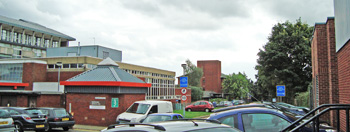
Land has been sold off for housing and the rather cramped site now contains the Gloucester Wing, the Moynihan Block, the Runcie Wing, the Waverley Wing and the Restaurant Block.

The main entrance of the Hospital is in Gloucester Wing.

The 5-storey Moynihan Block is located to the side of the low-level Gloucester Wing.

The Moynihan Block was built in the late 1960s.
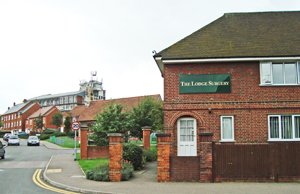
The Hospital, as seen from the former Sisters Hospital site. The Moynihan Block is in the background, with the chapel in the mid ground.
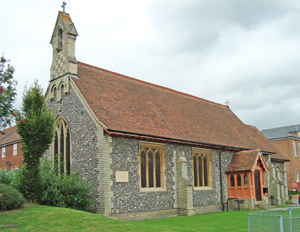
The chapel was built in 1893 for the workhouse. It has a small bell tower and a stained glass window, which is a war memorial designed by Christopher Webb and installed in 1952.
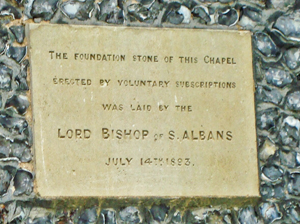
The foundation stone for the chapel was laid on 14th July 1893 by the Lord Bishop of St Albans.
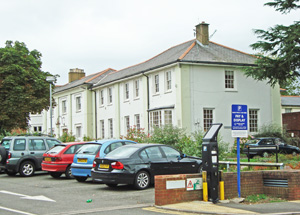
Oster House West has been demolished, but Oster House East remains (above and below). It is now used as accommodation for young people and adults who require supported living.
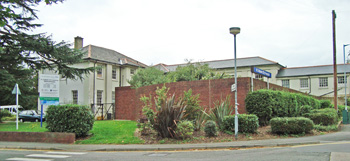
Adams M 2017 Community wards to close at St Albans City Hospital. Herts Advertiser, 21st February.
Adams M 2017 Herts Ad Comment: Questions over future of St Albans City Hospital. Herts Advertiser, 4th September.
(Author unstated) 1923 The Hospital World. British Journal of Nursing, 20th October, 251.
Brannen A 2011 St Albans Hospital replaces volunteer tea bar with Costa Coffee chain. Herts Advertiser, 27th January.
Cherryman B 2014 Concerns over future of St Albans City Hospital as cash crisis deepens. Watford Observer, 23rd July.
Cherryman B 2015 £1m investment for St Albans City Hospital. Watford Observer, 27th March.
Perring R 2014 'Excellent services must remain at St Albans City Hospital ' says MP Anne Main. Watford Observer, 24th June.
Sleigh JC 1948 Annual Report of the Medical Officer of Health. St Albans, Harpenden Urban District Council, 16.
Whieldon F 2017 St Albans City Hospital petition reaches 700 signatures. Herts Advertiser, 27th April.
http://calm.hertsdirect.org
http://hertfordshire-genealogy.blogspot.co.uk
http://lifetimenurse.blogspot.co.uk
https://api.parliament.uk (1) Jun 64
https://api.parliament.uk (2) Feb 65
https://api.parliament.uk (3) Dec 80
https://api.parliament.uk (4) Dec 87
https://api.parliament.uk (5) Feb 93
https://en.wikipedia.org
https://units.renal.org
www.a1taxis.net
www.geograph.org.uk
www.gsci.co.uk
www.haroldbeck.org.uk
www.stalbans.gov.uk
www.mysurgerywebsite.co.uk
www.watfordobserver.co.uk Jan 1998
www.westhertshospitals.nhs.uk (1)
www.westhertshospitals.nhs.uk (2)
www.westhertshospitals.nhs.uk (3)
www.workhouses.org.uk
Return to home page